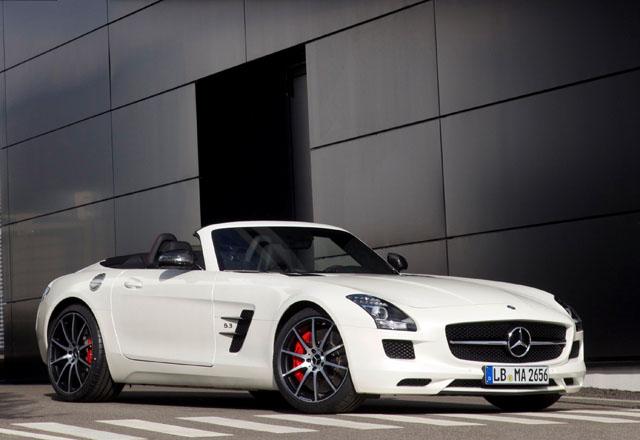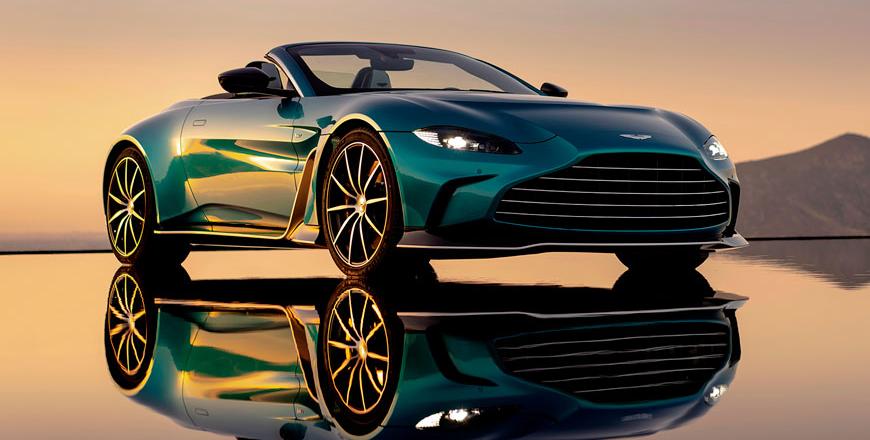Introduced one year after its coupe sister, in 2011 in entry level guise and joined by the featured and upgraded GT version in 2013, the Mercedes-Benz AMG SLS63 Roadster nears the end of the road as production is set to cease this year, to give way for an anticipated smaller sports car. While the new model is expected to be a more powerful and modern turbocharged rival for the Jaguar F-Type and Porsche 911, the outgoing SLS is flamboyant grand touring supercar with a gloriously potent large displacement naturally aspirated V8, at its most glamorously nostalgic in its rag-top Roadster version.
Classic proportions
While the expected departure of the SLS63 Roadster will still leave Mercedes with a big and brutally powerful grand touring roadster in the AMG SL63, the SLS is nevertheless a more sporting, viscerally inspired and special machine, with both its naturally aspirated power plant and cloth roof — rather than twin-turbo engine and folding hardtop — separating it. However, what distinguishes the SLS Roadster is its sense of style and its classic sports car architecture, the former of which is partly dependent on the latter’s front-mid engine and rear transaxle gearbox configuration, which allows for and necessitates its distinctively long and slinky low bonnet.
Paying homage to the classic 1950s 300SL Coupe and Roadster, the SLS63 GT is low and wide with a distinctly rearwards cabin and one of the longest snouts in the car business. Though its proportions are classic and its slim but wide one-slat wire-mesh grille certainly hark to the past, the SLS isn’t an overtly “retro” design, and in Roadster guise trades the coupe’s trademark up-swinging “gullwing” doors for regular doors. With low and rakish windscreen, cabin-rear design and short and low boot, the Roadster may not be as dramatic as the Coupe, but is probably the prettier and more glamorous of the two
Consistent urge
Set low and far back in its bonnet, the SLS’ massive 6.2-litre V8 engine is one of the world’s great engines, with consistent abundance, progressive character and high-rev precision. Soon to be discontinued too, in favour of lower revving and less charismatic but more powerful and efficient forced induction engines across the board, the SLS’ big naturally aspirated V8 was only introduced in the mid-2000s. AMG’s first fully in-house developed design, the high revving 6.2 allowed one to more precisely dial in power for better handling characteristics in not un-sticking the rear tires too easily or unintentionally, and features a long-legged range of charisma and aggressive acoustics.
An upgraded version for most markets and a replacement for the regular SLS63, at the heart of the GT version is a 20BHP power hike, which raises output to 583BHP at 6,800rpm, while torque remains the same at 479lb/ft at 4,750rpm. With crackling immediacy, the GT Roadster launches off-the-line without delay and rips through the revs with a consistent and seemingly never-ending urgency. Responsive and abundant, the GT Roadster’s large displacement means that its eagerness and throttle precision don’t sacrifice brutal low- and mid-range flexibility, and its feels prodigiously powerful at virtually any speed or gear, as it briskly accumulates speed.
Bass and brawn
At 1,735kg, the GT Roadster is marginally heavier than the 1,695kg Coupe and with traction being paramount in translating its staggering power into off-the-line acceleration, its 3.7-second 0-100km/h headline acceleration figures — and 320km/h top speed — don’t differ. Brawny, bassy and bellowing, the GT Roadster’s deep and rich audios are aggressively insistent, and grow to sustained WW2 fighter plane-like howls at speed. In fact, even with the Roadster’s fabric roof, the 6.2’s charismatic acoustics have a greater and more visceral presence. With a more enjoyably textured soundtrack, one better appreciates exhaust pops and crackles than in the hardtop Coupe.
With the gearbox located on the rear axle and a race-style dry sump design for more consistent oil lubrication through strong lateral g-forces and compact size, the GT Roadster’s engine is set low and far behind the front axle for improved weight distribution and a low centre of gravity. With revised shift points, the SLS63 GT’s seven-speed automatic gearbox felt smoother and more concise in its’ automatic Sport mode, while Sport+ mode drove in a highly aggressive fashion, holding gears longer and downshifting eagerly, to keep the engine raring to go. Manual shifts through the steering-mounted paddle shifters also seemed quicker and more responsive.
Viscerally charged
Set low and far back in the GT Roadster’s hunkered down cabin, one’s view line includes an upright leather-bound dashboard with classic inspired cross-hair air vents, clear instrumentation and the thick contoured sports steering wheel and to the long bonnet beyond, whose length one adapts to when negotiating tight and quick slaloms. During slaloms the GT Roadster turned in crisply, with quick steering, taut body control, precise throttle control and good rear grip allowing one to weave through briskly. However, driven more with less finesse and more outright aggression, the immensely powerful GT Roadster can easily break rear traction and grip to set off its electronic stability controls.
Driven too aggressively the GT Roadster’s electronic stability controls are effective at keeping things in check, but it is far more entertaining and rewarding to drive on the edge of its mechanical grip limits. Driven at the Yas Marina Formula One circuit in Abu Dhabi, the GT version however seemed to benefit from less intrusive electronic stability controls than the regular SLS63, while revised adaptive suspension rates kept it taut and poised through corners. A more viscerally charged experience than the more refined and rigid GT Coupe, the Roadster felt a little more thrilling through tight hard corners and on high speed straights.
SPECIFICATIONS
Engine: 6.2-litre, dry sump V8-cylinders
Bore x stroke: 102.2 x 94.6mm
Compression ratio: 11.3:1
Valve-train: 32-valve, DOHC, variable timing
Gearbox: rear-mounted 7-speed MCT wet-clutch automatic, rear-wheel-drive
Gear ratios: 1st 3.4:1; 2nd 2.19:1; 3rd 1.63:1; 4th 1.29:1; 5th 1.03:1; 6th 0.84:1; 7th 0.72:1
Reverse / final drive ratios: 2.79:1 / 3.67:1
0-100 km/h: 3.7-seconds
Maximum speed: 320km/h
Power, BHP (PS) [kW]: 583 (591) [435] @ 6,800rpm
Specific power: 93.9BHP/litre
Power-to-weight: 336BHP/ton
Torque, lb/ft (Nm): 479 (650) @ 4,750rpm
Specific torque: 104.7Nm/litre
Fuel consumption, urban / extra-urban / combined: 19.9 / 9.3 / 13.2 litres/100km
CO2 emissions, combined: 308g/km
Fuel tank capacity: 85-litres
Luggage volume: 173-litres
Length: 4,638mm
Width: 1,939mm
Height: 1,262mm
Wheelbase: 2,680mm
Track width, F/R: 1,682 / 1,653mm
Kerb weight: 1,735kg
Aerodynamic drag co-efficient: 0.36
Steering: power assisted, rack and pinion
Turning circle: 11.9-meters
Suspension, F&R: Double wishbones
Brakes, F&R: Ventilated discs
Tyres, F/R: 265/35R19 / 295/30R20



















